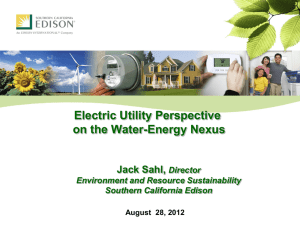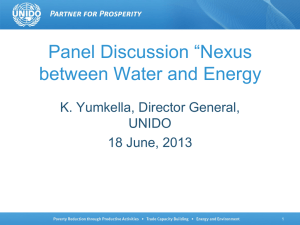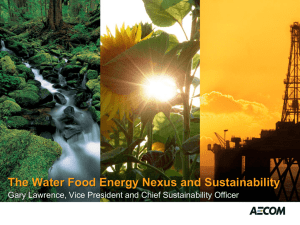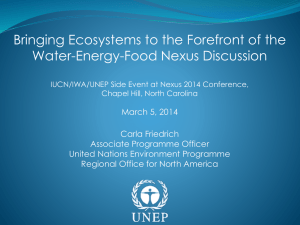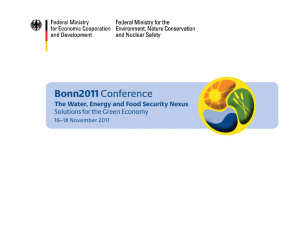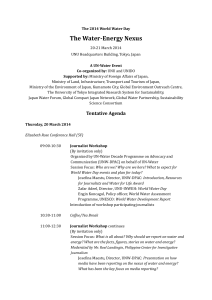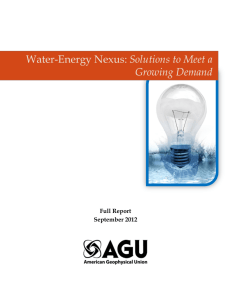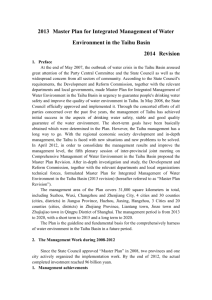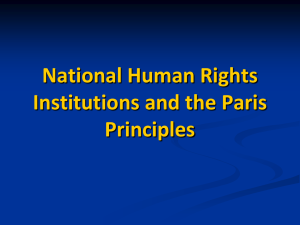Urban water security – Water-energy
advertisement
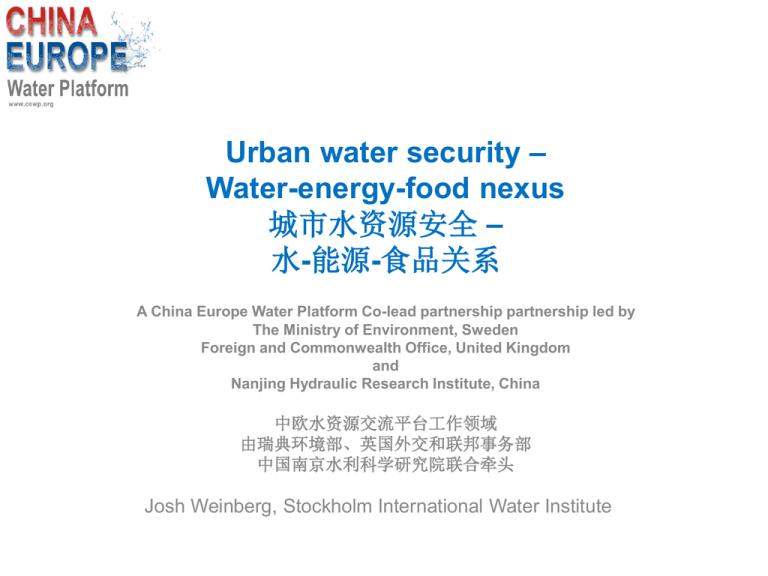
Urban water security – Water-energy-food nexus 城市水资源安全 – 水-能源-食品关系 A China Europe Water Platform Co-lead partnership partnership led by The Ministry of Environment, Sweden Foreign and Commonwealth Office, United Kingdom and Nanjing Hydraulic Research Institute, China 中欧水资源交流平台工作领域 由瑞典环境部、英国外交和联邦事务部 中国南京水利科学研究院联合牵头 Josh Weinberg, Stockholm International Water Institute Urban Water Security: Water-Energy-Food Nexus 确保城市水资源安全:水-能源-食品关系 Objectives: •Exchange between Chinese and European authorities on state of the art approaches and technologies •Improve methods for analyzing synergies and conflicts between the major water uses of domestic, industrial, agricultural and energy production in urban areas •Improve policy coherence between water and energy in China and the EU Key activities: •Taihu Basin Region Urban Water Security Programme •Managing water risks in China’s energy sector •Managing energy risks in China’s Urban Water Sector •Sustainable and intensive agriculture for urban areas 目标: •中国和欧洲当局之间在先进方法和技术方面的交流 •改进对城市地区居民、工业、农业和能源生产主要用水之间合成效应和冲突的分 析方法 •提高中国和欧盟在水资源和能源之间的政策一致性 主要活动: •太湖流域地区城市水资源安全项目 •管理中国能源领域的水资源风险 •管理中国城市水资源领域的能源风险 •城市地区的可持续和集约型农业 2 Water-Energy-Food Nexus Nexus snapshots • • • • Global water demand (in terms of water withdrawals) is projected to increase by some 55% by 2050 (WWDR 2014) Global energy demand to grow by onethird by 2035 - with fastest growth in Asia at 2.3 per cent per annum. (IEA 2010) US & EU- 40-50 % water withdrawal for energy (Granit & Lindström, 2011). Food production and supply chains use 30% of total global energy demand (UNECE 2013) Global trends and drivers - Water scarcity: Aggregated global water supply gap, estimated to be 40% by 2030 assuming no efficiency gains Increased climate variability intensifies existing problems More than 75% of river flows are allocated to agriculture, industries or domestic purposes Water resources can be abundant but lack of investment makes them unavailable for exploitation Global trends and drivers - Increasing food demand – available land area for agriculture is reducing FAO, 2011 Projected energy demand - Increases by 40 % to 2035 • Oil: 18% • Coal: 25% • Natural gas: 43 % • Nuclear: 70% • RE: Grows the fastest in relative terms- little impact in absolute terms – Includes most water efficient options IEA; 2012 Urbanization is driving demand for energy, food and water 60-80% of commercial energy consumption in cities Water needs for energy production will grow at twice the rate of energy demand. Urban lifestyles increase consumption of water intensive foods Common Urban Nexus Challenges in China and Europe 中国和欧洲面临着共同的城市关系挑战 - Growing water and energy demand resulting from urban growth - Coherence of energy and water policy - Linking resource management to spatial planning - Growing water demand for energy production - Need for optimisation of urban infrastructure for water and energy efficiency - Technical knowledge gap on water risks in unconvential energy - 城市发展导致的不断增长的水资源和能源需求 - 能源和水资源政策的一致性 - 水资源管理与空间规划的关系 - 不断增长的能源生产对水资源的需求 - 优化城市水资源和能源效率基础设施的需求 - 在非传统能源水资源风险方面技术知识的欠缺 9 Summary of key activities Taihu Region Urban Water Security Programme This program seeks to apply and develop a methodology for operationalizing nexus approach at a regional scale in the Chinese context. It will: • • • Map and assess water and energy inter-linkages in the Taihu basin and how those are impacted by the urbanization process. Perform pathway and policy analysis to increase water-energy resource use efficiency Devise regional sustainable intensification development strategy Managing water risks in China’s energy sector This programme will provide a systematic review and forecast on the water reserve in China’s main energy bases with detailed situation, current utility condition and main feature. It will: • Establish a quantitative model calculating the main energy bases maximum production scale considering local water carrying capacity. • Provide policy proposal suggesting the main energy bases energy type, production methods and scale in the “Energy Thirteenth FiveYear Plan” to achieve both water and energy SDGs. Water Evaluation and Planning System Water Supply Water Demand Energy Demand Energy Supply Long range Energy Alternatives Planning Tai Basin Urban Water Security Programme (2015-2017) This program seeks to apply and develop a methodology for operationalizing nexus approach at a regional scale in the Chinese context. Water Evaluation and Planning System • Map and assess water and energy inter-linkages in the Tai basin and how those are impacted by the urbanization process. • Perform pathway and policy analysis to increase water-energy resource use efficiency • Devise regional sustainable intensification development strategy Long range Energy Alternatives Planning Implementation team Partnership: – The project will be implemented by a partnership led by NHRI. SEI will be the coordinating oversea organization. SIWI, Deltares and TBA are also important partners. Project team: – The project team is going to be made up by 20 specialists, of which 12 are from NHRI, 3 from SEI, 2 from SIWI, and 3 from Deltares. Labor division: Nexus studies TBA Nexus Application SEI NHRI: Overall implementati on and coordination Deltares Adaptation studies SIWI Hydroenvironmental impacts Tai Basin Urban Water Security Programme (2015-2017) Programme objectives: • Assess of water-energy nexus under rapid Water Evaluation and Planning System urbanization in China which fits the country; • Evaluate the adaptation of regional energy allocation and water supply, and search for optimized waterenergy allocation strategies for sustainable urbanization; • Provide policy recommendations for optimized water-energy allocation and usage. Long range Energy Alternatives Planning Tai Basin Urban Water Security Programme (2015-2017) Expected Outputs: • Analytic system of planning and management of water-energy nexus; • Forecast and assessment of hydroenvironmental impacts of point-group energy distribution • Forecast model of regional water-energy nexu • Assessment system of water-energy allocation for urbanization in China. Planned cooperation activities: • Annual seminars and workshops • Published papers and patents; • Regular staff exchange, and 3-5 PHD/Master students. Water Evaluation and Planning System Long range Energy Alternatives Planning Tai Basin Urban Water Security Programme (2015-2017): Timeline YEAR 1 (04.2015-03.2016): Context and background analysis – understanding the water-energy nexus • One workshop in Europe and one in China • Background report on the changing water-energy nexus in the Taihu basin from 1980 to 2010 (or with the most year with data) • Two research papers Water Evaluation and Planning System YEAR 2 (04.2016-03.2017): Water-energy nexus scenario analysis: Identifying sustainable intensification pathways, nexus innovation, policy and technology solutions • One workshop in Europe and one in China • Research report on water-energy nexus scenario analysis and sustainable development pathway for the Taihu Basin • Four research papers YEAR 3 (04.2017-03.2018): Synthesis, communication and dissemination • Synthesis report on an operational approach for water and energy nexus research in the context of urbanization. • Knowledge exchange and dissemination • One workshop in Europe and one in China • Two research papers Long range Energy Alternatives Planning 水专项规划案例分享 Cases of water special plan Case Studies – Qingdao Water Energy Nexus 案例研究-青岛水和能源纽带 Qingdao DRC Qingdao Water resources Department Qingdao: Water Use 2011 青岛:2011年水利用 1. Understand city Water resources 40% of local water resources has been exploited for the city. water supply. 该城市40%的当地水资源已经被消 耗掉。 Local Surface Transfer Yellow R Local Groundwater Recycled water Desalinated Qingdao: Sankey Diagram - Water Use 2011 青岛市2011年水源分配与利用桑基图 城市供水:非传统水资源的利用带来城市供水能源强度的迅速增长 (青岛) Water Supply: Increased energy intensity with the use of non traditional water resources 2. Energy associated with Water resources 4 .0 Local surface water本地地表水 3 .5 Water transfer (from the Yellow River)引黄 Reclaimed water再生水 Water transfer (from the Yangtze) 引长江水 Energy requirement能源 要求 (kWh/m3) Desalination (brackish water) 淡化(苦咸水) Desalination (seawater)淡化(海水) 2 .5 High cost, energy consumption, environmental and social risks 高成本、能源消耗、 环境和社会风险 Local groundwater本地地下水 3 .0 4 .0 0 2 .0 1 .5 1 .4 0 1 .1 4 1 .0 0 .7 0 0 .8 2 0 .7 8 0 .4 3 0 .5 0 .0 0 200 400 600 800 1 ,0 0 0 1 ,2 0 0 1 ,4 0 0 1 ,6 0 0 1 ,8 0 0 W a ter sup p ly p otential (m illion m 3 ) 2 ,0 0 0 2 ,2 0 0 2 ,4 0 0 2 ,6 0 0 ∞ Example: Energy Requirements of Different Scenarios 举例:不同情景下的能源要求 3. Develop and test Scenarios Recommendations建议 •To meet future demand Qingdao must exploit unconventional water resources 为满足未来需求,青岛必须利用非传统水资源 • long-distance water diversion, 长距离输水 • reclaimed water, 再生水 • seawater desalination. 海水淡化 •The Choice of water source allocation will have a direct impact on the energy consumption and carbon emissions •水源分配的选择会直接影响能源消耗和碳排放 •Wastewater recycling the most energy efficient option •废水回收再利用是能源效率最好的方案 •Alternative is to take from farming, with social and economic consequence •替代方案是占取农业用水,但是会带来社会经济后果 Achievements and Next Steps 成果和下一步工作 Achievements: • Partnership agreements between multiple parties • 2 programmes in progress, 1 completed • 1 research programme submitted to Chinese Ministry of Science and Technology to begin in January 2015 • Water energy nexus scoping case study performed in Ningxia • Workshops and knowledge exchange on nexus Plans: • Urban Water Security Governance Programme, October-November 2014 • Taihu Regional Urban Water Security Programme Inception (2015-2017) • Policy proposal for 13th 5 year plan for Energy to achieve water and energy SDG (March 2015) • Staff and technical exchanges between partners (Spring 2015) 22 成果: • 多个合作方之间的合作协议 • 2个项目正在进行中,一个已经完成 • 1个将在2015年1月开始的研究项目已经提交给 了中国科学技术部 • 在宁夏进行了水资源-能源关系调查案例研究 • 关于欧盟和中国合作关系的研讨会、介绍和知识 交流 计划: • 城市水资源安全治理项目,2014年10月-11月 • 启动太湖地区城市水资源安全项目(2015年2017年) • 为实现水资源和能源可持续发展目标提出“十三 五计划”政策建议(2015年3月) • 合作方之间的人员和技术交流(2015年春季) Event assisted by the EU China Policy Dialogues Support Facility 本项目得到中欧政策对话支持项目的支持 Contacts 联系人 Guoyi Han, Stockholm Environment Institute, guoyi.han@sei-international.org Josh Weinberg, Stockholm International Water Institute, josh.weinberg@siwi.org Wu Shiqiang, Nanjing Hydraulic Research Institute, sqwu@nhri.cn Christian Romig, UK Embassy in Beijing, Christian.Romig@fco.gov.uk Simon Spooner, Atkins International, simon.spooner@atkinsglobal.com 韩国义,斯德哥尔摩环境研究所, guoyi.han@sei-international.org 乔希·温伯格,斯德哥尔摩国际水资源研究所, josh.weinberg@siwi.org 吴士强,南京水利科学研究院,sqwu@nhri.cn 克里斯蒂·安罗米格,英国驻中国北京大使馆, Christian.Romig@fco.gov.uk 西蒙·斯普纳,阿特金斯国际,simon.spooner@atkinsglobal.com Full list of participating organizations: Swedish Ministry of Environment, UK Foreign Commonwealth Office, Ministry of Water Resources/CEWP China Secretariat, Stockholm Environment Institute, SIWI, Atkins International, Nanjing Hydraulic Research Institute, Institute for Water and Hydropower Research, Stockholm Royal Institute of Technology, Applied Energy Innovation Center, MWR-DRC, World Resources Institute, GIWP, ChangCE 完整的参与机构列表: 瑞典环境部、英国外交和联邦事务部、水利部/中欧水资源交流平台中国秘书处、斯德哥尔 摩环境研究所、斯德哥尔摩国际水资源研究所、阿特金斯国际、南京水利科学研究院、水 利水电科学研究院、斯德哥尔摩皇家理工学院、应用能源创新中心、水利部研究发展中心 、世界资源研究所、长策智库 Event assisted by the EU China Policy Dialogues Support Facility 23 本项目得到中欧政策对话支持项目的支持 Thank you! 谢谢! 24 Event assisted by the EU China Policy Dialogues Support Facility 本项目得到中欧政策对话支持项目的支持
